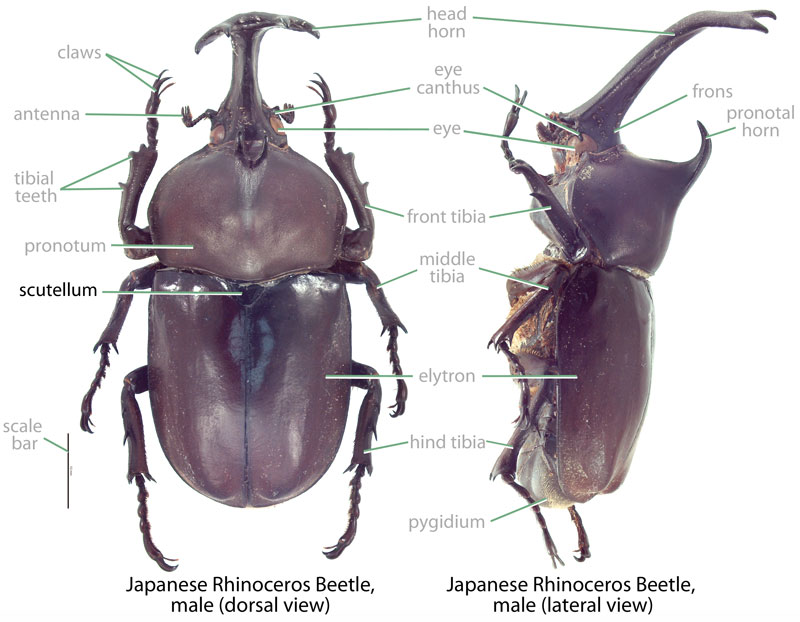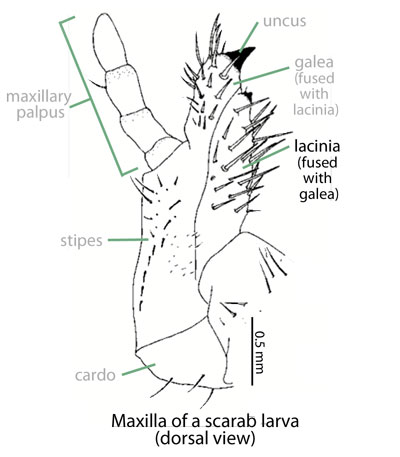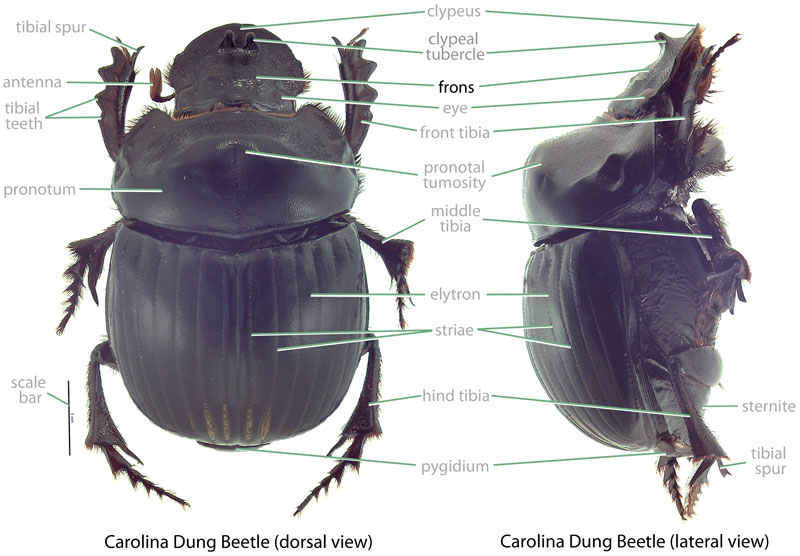Beneficial
none known
Family: Scarabaeidae Subfamily: Scarabaeinae Genus: Onthophagus Species: Onthophagus incensus Say, 1835
DNA barcode available: specimen information
Total body length 6.5–12.0 mm (0.25–0.47 in). Body shape oval; may be caked in dung. Color shiny black, with bluish or greenish hues under bright light. Small to medium-sized dung beetle, over 6 mm. Clypealclypeal:
of, or referring to, the clypeus
apexapex:
point or edge furthest from the body
of major male produced, quadratequadrate:
square-like in shape
or trapezoidal; comparatively rounded in minor male and female. Head of major male with 2 slightly curved, vertically-oriented horns that are not connected by a ridge and with apices that are not bifurcatebifurcate:
a process dividing into two points
; minor male with horns reduced or replaced by straight, transversetransverse:
extending horizontally across a surface
ridge; female with transversetransverse:
extending horizontally across a surface
ridge near base. Ocular canthuscanthus:
a process extending over and sometimes dividing the eye
completely dividing eye. Pronotumpronotum:
the dorsal surface of the thorax
 of major male with hump-like process; minor male with hump reduced to small bi-lobedbi-lobed:
of major male with hump-like process; minor male with hump reduced to small bi-lobedbi-lobed:
possessed of two lobe-like structures
process; female lacking process. Pronotumpronotum:
the dorsal surface of the thorax
 with anterioranterior:
with anterioranterior:
the front or forward; opposite of posterior
angles rounded in both sexes. Front tibiatibia:
a segment of the leg articulated with the tarsus and femur
 of male slightly slender and elongate, female tibiatibia:
of male slightly slender and elongate, female tibiatibia:
a segment of the leg articulated with the tarsus and femur
 comparatively stout. Scutellumscutellum:
comparatively stout. Scutellumscutellum:
the triangular portion of the thorax between the bases of the elytra
 absent.
absent.
(Huerta et al., 2010Huerta et al., 2010:
Huerta C, Martinez I, García-Hernández M. 2010. Preimaginal development of Onthophagus incensus Say, 1835 (Coleoptera: Scarabaeidae: Scarabaeinae). The Coleopterists Bulletin 64: 365-371. DOI: 10.1649/0010-065X-64.4.365): Grub C-shaped, hump-backed, cylindrical, and cream-colored. Maxillamaxilla:
set of paired mouthparts located posterior to the mandibles
with galeagalea:
outer branch or lobe of the maxilla
 and lacinialacinia:
and lacinialacinia:
inner portion of the maxilla distinctly separate. Labium hypopharynx glossaglossa:
distinctly separate. Labium hypopharynx glossaglossa:
paired terminal lobes of the labium
with 4 or 5 setaesetae:
small, hair-like structure
of the lateral lobe; 9–12 setaesetae:
small, hair-like structure
and 4 macrosensillamacrosensilla:
small sensory spot(s) located on the epipharynx
on the central lobe. Lacinialacinia:
inner portion of the maxilla with 2 or 3 dorso-basal setaesetae:
with 2 or 3 dorso-basal setaesetae:
small, hair-like structure
. Maxillary palps with single setaesetae:
small, hair-like structure
. Maxillary stridulatory area with a row of 8 short, conical teeth. Cardocardo:
basal (first) segment of the maxilla with 3 external setaesetae:
with 3 external setaesetae:
small, hair-like structure
. Epipharynxepipharynx:
lobe on the interior surface of the labrum or clypeus
with tormaetormae:
in scarab larvae, sclerotized structures on the ends of the clypeolateral suture extending towards the mesal line
united mesallymesally:
at or near midline of body
. Epipharyngeal phobaphoba:
in scarab larvae, an area of dense, often forked setae at the posterior inner edge of the paria
 with teeth small and conical; chaetopariachaetoparia:
with teeth small and conical; chaetopariachaetoparia:
inner, bristle-covered portion of the paria
 with 2 or 3 setaesetae:
with 2 or 3 setaesetae:
small, hair-like structure
. Epicranial stemepicranial stem:
in scarab larvae, the stem of the epicranial suture dividing the top of the head
shallowly forked basally on fronsfrons:
part of the head generally positioned between the eyes (posterior to the clypeus and anterior to the vertex) and visible dorsally
 . mesallymesally:
. mesallymesally:
at or near midline of body
.-segmented, distaldistal:
situated away from the point of articulation, thus usually furthest from the body
segment much reduced. Legs 2-segmented. Prothoracic shieldprothoracic shield:
the chitinous plate behind the head of larvae
 without anteriorly projecting processes.
without anteriorly projecting processes.
United States to Ecuador. This species is recorded from Texas through Mexico and Central America southward to Venezuela and Ecuador (Huerta and García-Hernández, 2013Huerta and García-Hernández, 2013:
Huerta C, García-Hernández M. 2013. Nesting behavior of Onthophagus incensus Say, 1835 (Coleoptera: Scarabaeidae: Scarabaeinae). The Coleopterists Bulletin 67: 161-166. DOI: 10.1649/0010-065X-67.2.161).
None. This species feeds on dung as both an adult and larvalarva:
the immature form of an insect; in scarabs, also called grub or white grub; preceded by the egg stage, followed by the pupal stage
 . There are no records of this beetle feeding on live plant tissues.
. There are no records of this beetle feeding on live plant tissues.
(Huerta and García-Hernández, 2013Huerta and García-Hernández, 2013:
Huerta C, García-Hernández M. 2013. Nesting behavior of Onthophagus incensus Say, 1835 (Coleoptera: Scarabaeidae: Scarabaeinae). The Coleopterists Bulletin 67: 161-166. DOI: 10.1649/0010-065X-67.2.161; Huerta et al., 2010Huerta et al., 2010:
Huerta C, Martinez I, García-Hernández M. 2010. Preimaginal development of Onthophagus incensus Say, 1835 (Coleoptera: Scarabaeidae: Scarabaeinae). The Coleopterists Bulletin 64: 365-371. DOI: 10.1649/0010-065X-64.4.365): This diurnaldiurnal:
active during daylight hours
species is associated with pasture land near tropical forests. After locating suitable dung, adults construct a gallery of tunnels 5–15 cm (1.9–5.9 in) beneath the fecal source. Tunnels are provisioned with dung in the form of brood balls. Each brood ball is impregnated with an egg and larval development occurs within. The number of brood balls appears to be seasonally dependent, increasing with onset of the rainy season. Development from egg to adult is about 38 days. There are multiple generations per year.
None. This species recycles dung and is beneficial for ranching and farming in Hawaii. Being a dung feeder, this species has never been recorded damaging crops or ornamental plants. Additionally, this species is not a threat to native dung beetles because none occur in Hawaii or Guam.
Established. This species was introduced to Big Island and Oahu in 1923 to help control populations of the horn fly (Haematobia irritans), a biting pest of livestock (Markin and Yoshioka, 1998Markin and Yoshioka, 1998:
Markin G and Yoshioka E. 1998. Biological control of the horn fly, Haematobia irritans L., in Hawai'i (Diptera: Muscidae). Proceedings of the Hawaiian Entomological Society 33: 43-50. full text (accessed 2015)). It is fairly common on Oahu (mostly above 500 m) but less abundant on Big Island (Markin and Yoshioka, 1998Markin and Yoshioka, 1998:
Markin G and Yoshioka E. 1998. Biological control of the horn fly, Haematobia irritans L., in Hawai'i (Diptera: Muscidae). Proceedings of the Hawaiian Entomological Society 33: 43-50. full text (accessed 2015)).
Recorded, not established. This species was released on Guam in 1953 to help control populations of the horn fly (Haematobia irritans), a biting pest of livestock (Peterson, 1956Peterson, 1956:
Peterson G. 1956. An annotated checklist of parasites and predators introduced into Guam during the years 1950-1955. Proceedings of the Hawaiian Entomological Society 16: 199-202. full text (accessed 2015)). However, it failed to establish on the island (Cartwright and Gordon, 1971Cartwright and Gordon, 1971:
Cartwright O and Gordon R. 1971. Insects of Micronesia Coleoptera: Scarabaeidae. Insects of Micronesia 17: 256-296.; Bourquin, 2002Bourquin, 2002:
Bourquin O. 2002. Invertebrates recorded from the Northern Mariana Islands status 2002. CNMI Invertebrate Collection Crees-Northern Marianas College, Saipan.).
In both Hawaii and Guam, this species was intentionally imported.
This dung beetle could be confused with similarly colored, small to medium-sized (more than 6 mm) Onthophagus species such as Onthophagus binodis, Onthophagus cuniculus, Onthophagus laminatus, Onthophagus armatus, and Onthophagus comperei.
Major males of O. incensus are most readily distinguished by examining the head armature (O. incensus with two slightly curved, vertically-oriented horns that are not connected by a ridge, with apices not bifurcatebifurcate:
a process dividing into two points
versus O. binodis, and O. cuniculusthat both lack horns, O. comperei with sinuatesinuate:
gently curved (specifically of margins or edges); often in reference to the clypeus
horns that are weakly bifurcatebifurcate:
a process dividing into two points
, O. laminatus that has a distinct ridge between the horns, O. armatus with bisinuatebisinuate:
possessing two sinuate edges or portions, with two curves
horns connected by a distinct ridge).
Females can be separated by examining the base of the head (O. incensus with transversetransverse:
extending horizontally across a surface
ridge versus O. binodis and O. cuniculus with a slightly curved ridge, O. armatuswith feebly bisinuatebisinuate:
possessing two sinuate edges or portions, with two curves
ridge, O. compereiwith two tubercles), the pronotal process (O. incensus without a process versus O. binodis and O. laminatus with a small lobe-like process, O. cuniculus with a bi-lobedbi-lobed:
possessed of two lobe-like structures
process), and the anterioranterior:
the front or forward; opposite of posterior
pronotal angle (O. incensus with anterioranterior:
the front or forward; opposite of posterior
angle rounded versus O. cuniculusand O. laminatus with the anterioranterior:
the front or forward; opposite of posterior
angle curved outward).
none known
Report your observation of this beneficial species at our iNaturalist project.